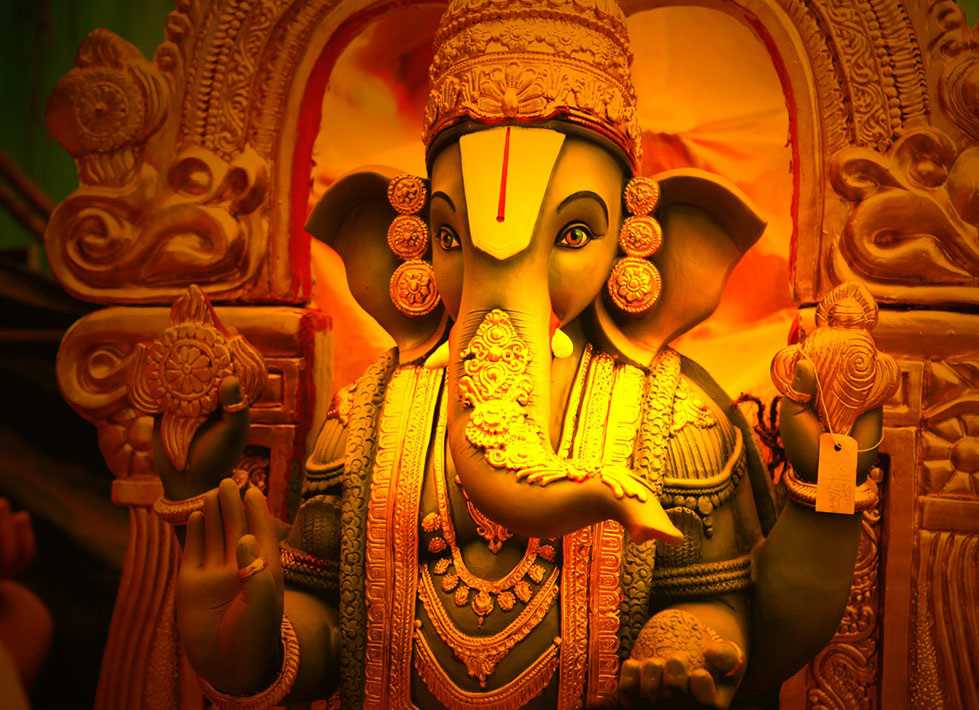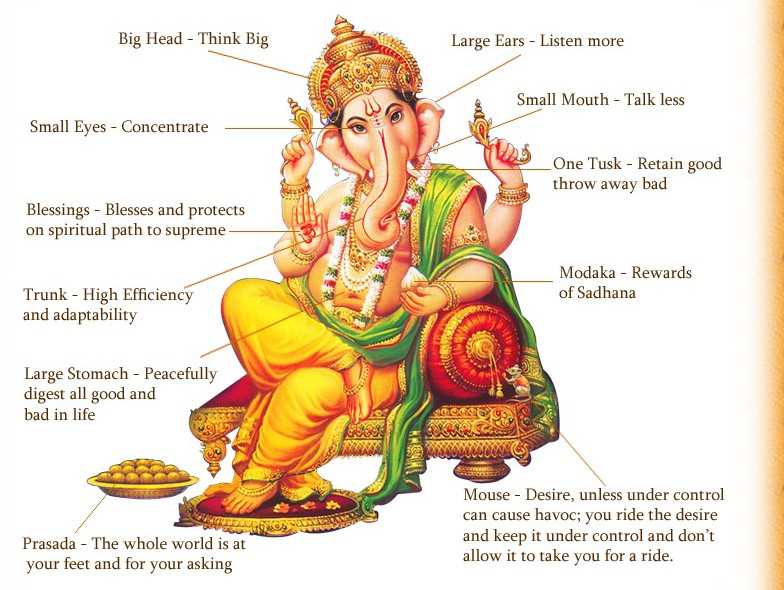No products in the cart.
Ganesha is one of the most famous and greatly worshiped deities in Hinduism. The main identity of Ganesha is his elephant like head. Lord Ganesha is invoked as Vighneswara at the launch of an event or business by majority of the Hindus as he is believed to be the obstacle remover. Lord Ganesha is also considered as the God of auspicious beginnings and bestower of fortune in abundance. He is the son of Lord Shiva and Hindu Goddess Parvati. Ganesha is known by many names and has many different forms. The Ganesha Purana describes the 32 forms of Lord Ganesha and among them, Mahaganapathi is widely worshiped. The first 16 forms of Ganesha are known by the name “Shodasa Ganapati” and the later ones are known as “Ekavimsathi”.
There are several layers of intricate meaning behind each part of Lord Ganesha.
Different Forms of Lord Ganesha
He is represented in various forms across the Hindu society. Bala Ganapati is one of the most adored depictions of Ganesha with his childlike nature. He has sugarcane, mango and a jackfruit in his hands and his favorite modaka, a sweet in his trunk.
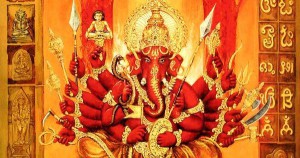
As Vira Ganapati he is depicted as a brave heart. Resplendent with a range of weapons in his several hands. Some of the weapons he holds are bow, sword, gada, spear, shield, battle axe and many more. Ganesha ‘s form might not instill fear among most people because of his child like qualities but according to Hindu mythology ganesha is a force to be reckoned with both physically and also intellectually. He stops the mighty Shiva from seeing parvati on orders from his mother parvati, which made lord Shiva furious and slay his head. Similarly In a bid to win the fruit, he acts smartly and goes around his parents and outruns kartikeya who went around the world thrice. These acts are proof to the mighty strength and intellect of vigneshwarar.
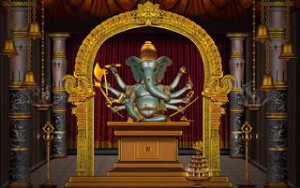
Vighna Ganapati, “Lord of Obstacles,” is of brilliant gold hue and bedecked in jewels. His eight arms hold a noose and goad, tusk and modaka, conch and discus, a bouquet of flowers, sugar cane, flower arrow and an axe.
Handsome, red-hued Kshipra Ganapati,”Quick-acting” giver of boons, displays His broken tusk, a noose, goad and a sprig of the kalpavriksha (wish-fulfilling) tree. In His uplifted trunk He holds a tiny pot of precious jewels.
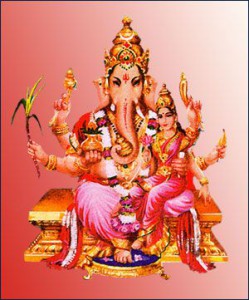
In the form of Lakshmi Ganapati he stands flanked by lakshmi the goddess of wealth. He holds the varada mudra in his hand and a sprig of kalpavriksha. Worshipping Lakshmi Ganapati is said to bless the devotee with wealth wisdom and knowledge.
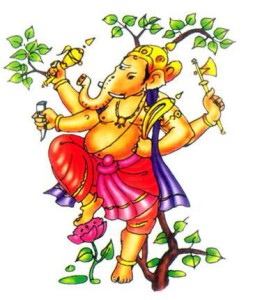
Ganapati is also depicted in his dancing form as Nritya Ganapati. Where he is depicted as dancing under the kalpa vriksha with great eccentricity and exuberance. In most depictions he is shown raising his right leg and the left leg is placed on the earth. This signifies the élan and grace with which he moves. It is believed that Ganesha used to entertain his parents and other gods with his dance.
In almost all depictions Ganesha is shown with his vahana the mouse. This symbolizes how a small mouse with the blessings of Ganesha can serve as the vahana for the lord himself. Some other meaning also say that the mouse signifies ego, arrogance and evil traits in us. Lord Ganesha sitting on the mouse means that one has to control all his desires and negative traits to attain blessings from god.
In the standing posture he remains straight with no bend in his posture. It is called as abhanga. This is a very formal depiction of lord Ganesha. Even in his standing posture he is shown as having one leg on the ground and another on his vahana, the mouse.
Another important posture of Ganesha that is commonly seen is the sitting posture. He is mostly seated on a lotus or a simhasana (throne). The pose is called as lalitasana in which one leg is folded and other is placed freely on the ground. The leg that touches the ground denotes that Ganesha is concerned about the worldly affairs to help his devotees. In another variation of the sitting pose he is seen sitting cross legged. This is a meditative pose.
In many paintings and artistic sculptures he is seen as reclined on a bed like structure. This gives the idol a royal and luxurious look. Such statues are said to bring the worshiper wealth,prosperity, comfort, success and luxury.
As the Sankatahara Ganapati, He is the dispeller of sorrow. He is seated on a lotus and has four arms holding a bowl of pudding, a goad and a noose while gesturing the boon-granting varada mudra. He also has His consort with Him.
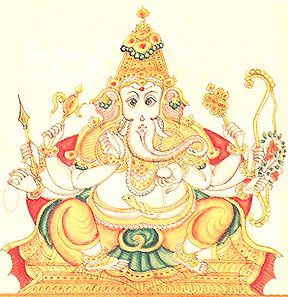
As Durga Ganapati, He is the invincible Ganapati paying tribute to Mother Durga and is depicted with 8 arms holding a bow and arrow, goad and noose, prayer beads, a rose apple and his broken tusk.
There also forms of Ganapati with two and three faces,they are called as dwimukha ganapati and trimukha ganapati respectively.
There are almost 32 ganesha forms based on the characteristics:-
- Bala Ganesha
- Taruna Ganesha
- Bhakti Ganesha
- Vira Ganesha
- Shakthi Ganesha
- Dvija Ganesha
- Siddhi Ganesha
- Ucchista Ganesha
- Vighna Ganesha
- Kshipra Ganesha
- Heramba Ganesha
- . Lakshmi Ganesha
- Maha Ganesha
- Vijaya Ganesha
- Nritya Ganesha
- Urdhva Ganesha
- Ekakshara Ganesha
- Varada Ganesha
- Tryakshara Ganesha
- Kshipra prasada Ganesha
- Haridra Ganesha
- Ekadanta Ganesha
- Shristi Ganesha
- Uddanda Ganesha
- Rinamochana Ganesha
- Dhuddhi Ganesha
- Dwimukha Ganesha
- .Trimukha Ganesha
- Sinha Ganesha
- Yoga
- Durga Ganesha
- Sankatahara Ganesha
Placing a ganesha idol or picture in the home is one of the first and foremost activities of any homeowner. This is because the statues of ganesha remove obstacles, bring luck and ensure success to the devotee. But one has to be careful while choosing idols for the home. It is preferable that one chooses a vinayaka idol with the trunk curved towards the left. When the trunk curves right, it is called valampuri vinayaka. The sun`s energies flow through the trunk. This form of Ganesha is called Siddhi Vinayaka, as it can immediately yield desired results. It needs special worship and one has to be very careful in keeping such idols at home. If prayers are not done as per Vedic rules, then it incurs the anger of the residing Lord and as the heat principle is governed by the Lord Sun, it burns away good results. Rules should never be violated and pooja should be done at the right time, in the right suitable way, which is very difficult for householders to adhere to. The dakshinabhimukhi idol or idol of Ganesha with trunk curved right is not usually worshipped at home as there is an emission of frequency waves coming from the south called Tiryak or raja frequency. When all Vedic norms are followed meticulously and worshipped accordingly, then it increases the sattwa or highly positive vibrations that can withstand the raja frequencies emitted from the south direction. When idols with trunk curved right are worshipped, it bestows boons of moksha or salvation. It liberates the soul from worldly fetters.
Idols with Straight Trunk are also made, these kinds of idols are hard to find, but are considered special. The idol with the trunk of Lord Ganesha in the air represents a state where his ‘Kundalini’ reached the peak. These idols are always good for any home and office.
For those who are fond of the artistic forms of ganesha that are available in the market, there is a word of caution. It is said that those idols do not conform to our traditional scriptures that describe how a ganesha idol should be. Artistic idols can be creatively used in interior decoration to bring in positive energy but they should not be worshipped or placed inside the puja room. Also when buying idols for pooja it is advisable to avoid dancing forms or nritya ganeshas and also statues that exceed the height of 18 inches.
Ganesha is the remover of obstacles that is why he is fondly called as vigneshwara. Worship towards ganesha can bring the person success in all his endeavors and also bless him with great intellect and wisdom.
Here, listen to the Dhyana Mantras of all the 32 Ganesha Forms.

